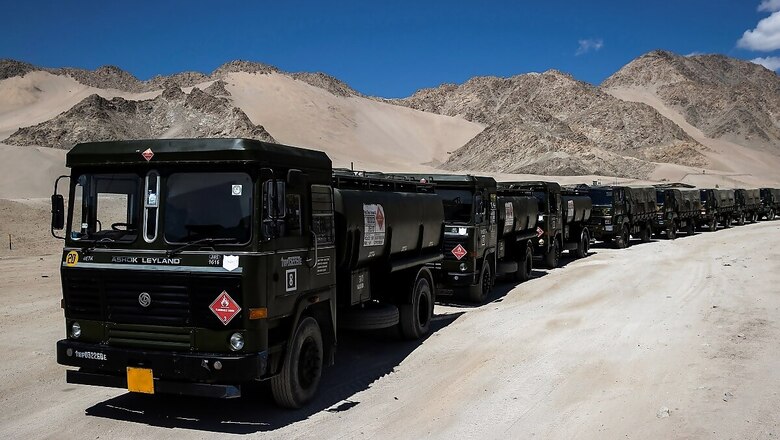
views
India on Monday pressed for an early and complete disengagement of Chinese troops from friction points in eastern Ladakh as senior army commanders from both the countries held a sixth round of talks to ease the prolonged border standoff. But the marathon discussion, which began at around 9 am in Moldo on the Chinese side of the Line of Actual Control (LAC) across India’s Chushul sector in eastern Ladakh and went on for 14 hours, did not bring any breakthrough, sources told News18.
Corps commander will brief the top security brass on the proceedings of the meeting. Corps commander from both sides have agreed to meet again in the near future.
It is learnt that the Indian delegation insisted on a time-bound implementation of the agreement finalised during the extensive talks between External Affairs Minister S Jaishankar and his Chinese counterpart Wang Yi in Moscow on September 10 on the sidelines of a Shanghai Cooperation Organisation(SCO) meet.
The Indian delegation is headed by Lt Gen Harinder Singh, the commander of the Leh-based 14 Corps of the Indian Army. For the first time, the Indian team for the military talks also included a senior official from the Ministry of External Affairs (MEA).
MEA Joint Secretary Naveen Srivastava, who has been engaged in diplomatic talks with China on the border row under the framework of the Working Mechanism for Consultation and Coordination (WMCC) on border affairs, was part of the delegation. The team also comprised Lt Gen PGK Menon, who is expected to succeed Singh as the commander of the 14 Corps next month, the sources said.
The sources said the Indian team insisted on an early and complete disengagement of troops by Chinese People’s Liberation Army(PLA) to end the four-and-a-half-month standoff, adding the agenda for the talks was to chart a specific timeline for implementation of the five-point agreement. The agreement aimed at ending the tense standoff included measures like quick disengagement of troops, avoiding action that could escalate tensions, adherence to all agreements and protocols on border management and steps to restore peace along the LAC.
At the previous five rounds of Corps commander-level talks, the Indian side has insisted on complete disengagement of Chinese troops at the earliest, and immediate restoration of status quo ante in all areas of eastern Ladakh prior to April. The face-off had begun on May 5. The fifth round of Corps commander talks on August 2 lasted for nearly 11 hours while the fourth round went on for nearly 15 hours on July 14.
Military sources, meanwhile, said the newly-inducted Rafale jets started carrying out sorties in various forward areas in eastern Ladakh as part of measures to give a boost to the overall combat readiness in view of the “provocative actions” by Chinese troops in the last three weeks. The deployment of French-made Rafale jets in Ladakh came less than 10 days after they were formally inducted into the Indian Air Force(IAF).
At a ceremony in Ambala on September 10 where five Rafale jets were inducted into the IAF, Defence Minister Rajnath Singh said this was crucial considering the atmosphere being created along the frontier and was also a “big and stern” message to those eyeing India’s sovereignty. The sources said the Indian Army has made elaborate arrangements to maintain the current level of troop and weapons deployment in all forward areas in eastern Ladakh and other sensitive high-altitude sectors in the harsh winter months when the temperature drops up to minus 25 degree Celsius.
They said the situation remained tense at both the southern and northern bank of the Pangong lake area as well as in other friction points. There have been at least three attempts by the soldiers of the PLA to “intimidate” Indian troops along the northern and southern bank of Pangong lake area in the last three weeks where even shots were fired in the air for the first time at the LAC in 45 years.
The situation in eastern Ladakh deteriorated after China unsuccessfully attempted to occupy Indian territory in the southern bank of Pangong Lake on the intervening night of August 29 and 30. On September 7, the Chinese troops again made an unsuccessful bid to close in on the Indian position and even fired shots in the air in the Mukhpari area of Rezang-La ridgeline on the southern bank of Pangong lake.
As Jaishankar and Wang were set to hold talks in Moscow, Chinese soldiers fired a barrage of “warning shots” in the air on the North Bank of Pangong lake to “intimidate” the Indian troops, Indian Army sources had said. India occupied a number of strategic heights on the southern bank of Pangong lake and strengthened its presence in Finger 2 and Finger 3 areas in the region to thwart any Chinese actions.
China has been occupying the areas between Finger 4 and Finger 8. The mountain spurs in the area are called Fingers.




















Comments
0 comment